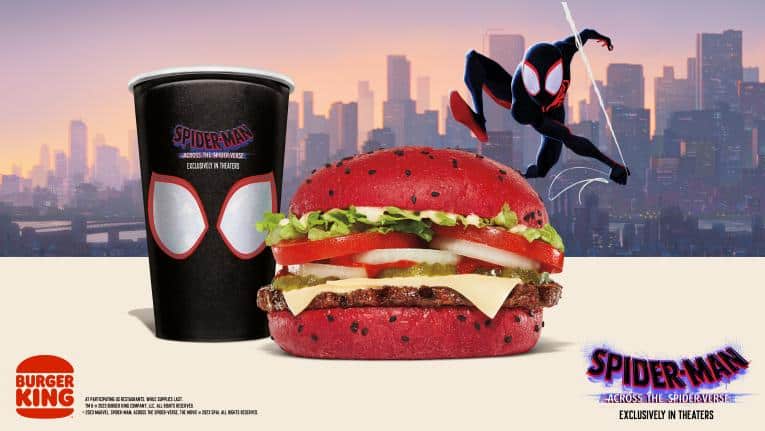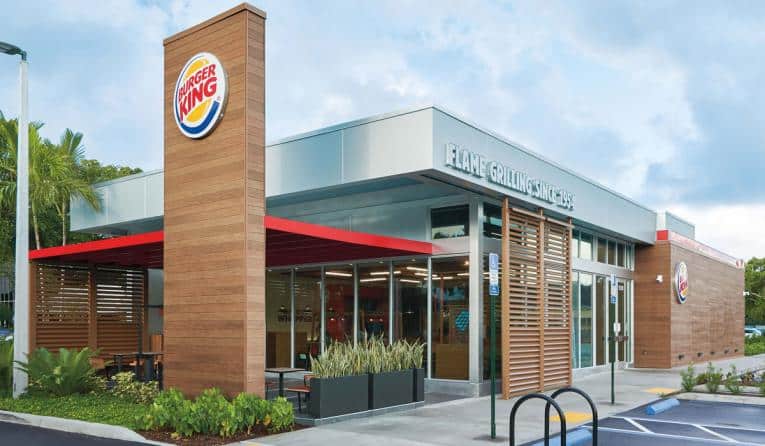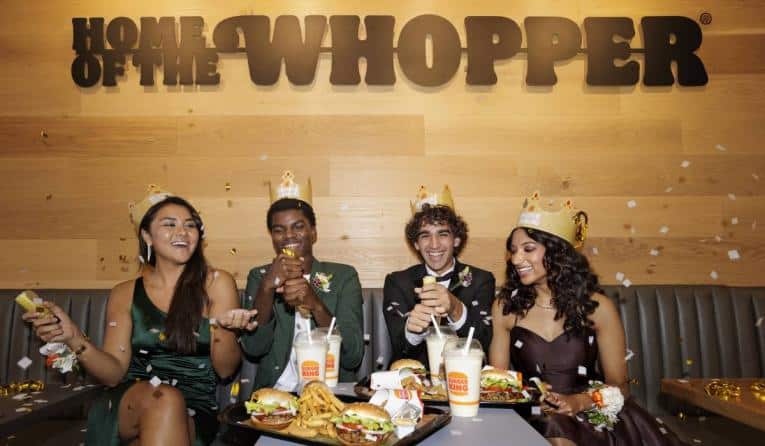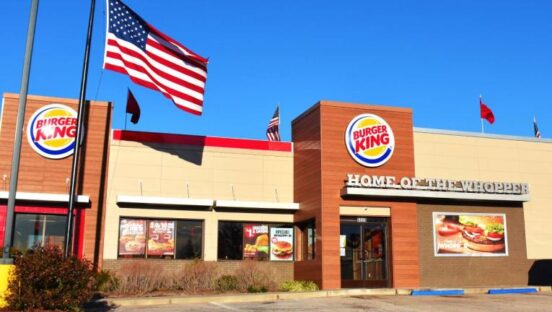In reality, Patrick Doyle’s influence on Burger King began well before his arrival as executive chair last November. It started in mid-May 2021 when Tom Curtis joined after 35 years at Domino’s. Curtis, who started as a store manager, became a franchisee, and eventually served as EVP of corporate operations and U.S. operations and support, had a clear view of Doyle’s blueprint at the pizza giant. Over a decade, Doyle led with franchisee health, culture, candid marketing, and tech progress to pull Domino’s from spiral to the No. 1 spot in the sector.
Speaking at the QSR Evolution Conference, Curtis says what originally attracted him to the corporate arm of Domino’s was the brand’s dedication to the franchise P&L and operator profitability. “When I say [Doyle] got here before he got here, I brought that with me from Domino’s,” Curtis says. “Because I saw the power. If you can get the franchisees making more money, they’ll put it back into the restaurants. These guys and girls who have been in the business for 30 or 40 years, ketchup in the veins, they love the brand. And if they have any opportunity, they’ll invest back into it.”
The simple truth, though, was when Curtis onboarded—and the same of Doyle—Burger King operators by and large didn’t have that kind of cash flow. “If we can get [that] going, we’ll turn this brand around,” Curtis says.
In the past year or so, Burger King hasn’t been shy about what’s ahead. The “Reclaim the Flame” is a $400 million outline scheduled to unroll across 2023 and 2024. In Q2, the company spent roughly $12 million of $150 million earmarked for advertising and digital goals. Burger King also deployed $9 million of $50 million intended for restaurant refreshes, including better equipment like toasters and broilers.
Participating franchisees are matching Burger King’s spend dollar-for-dollar in this deal. The third component—$200 million toward remodels—is underway as well. North of 75 percent of U.S. restaurants have committed to full remodels or scrape and rebuilds.
Overall, the brand spent $12 million in the quarter against its “Fuel the Flame” investment, including $10 million for advertising, and $11 million for “Royal Reset.” As of June 30, RBI funded $32 million for Fuel the Flame and $35 million on Royal Reset.
But let’s take it back further.
Curtis initially joined as COO. Four months later, he found himself sitting in the president’s chair. One thing Curtis knew on day one, he says, was Burger King needed to have a better culture around operations. “That needed to be what people woke up and thought about first and foremost every day,” he says.
So roughly two and half years ago, before Reclaim the Flame and all the plans that would follow, Curtis says initiatives started with rallying the organization. “We got everyone together, even the CMO, and every function of the organization, and we all agreed that hey, the guest experience is what counts,” he recalls.
Being a former franchisee (he was an operator longer than he’s been in corporate), Curtis was always drawn to an ops-centric style. Yet Burger King had to build a more visible plan as worked to improve day-to-day execution behind the scenes. And it came across four buckets: operations, marketing, great restaurant assets, and great franchisees.
“And frankly,” Curtis says, “Burger King needed all of those things, which was one of those points that excited me about coming here.”

“If they’re not passionate about serving guests than you can run all the strategy you want, it won’t make a difference and it won’t matter, and I knew that we had to get that energy down to the restaurant level,” Curtis says.
Burger King identified three beneficiaries to speak to—guests first; then team members; and next, franchisees. “I did not mention the brand because, if you take care of those three stakeholders, then the brand will take care of itself and the brand will thrive,” Curtis says.
The final element was critical, he says—all of it couldn’t be architected by Burger King corporate. Franchisees were in the field employing team members. “They’ve got to inject belief and passion and energy into the restaurant team,” Curtis says. “So the plan that we built was built by us and franchisees equally.”
An early component was “Royal Roundtables, which Burger King hosted dozens of in early 2023. Restaurant managers and franchisees across the U.S. gathered to voice thoughts and learn about how to proceed.
“Once again, having been a franchisee for 20 years … I know how important it is that team members are passionate about serving guests,” Curtis says. “If they’re not passionate about serving guests than you can run all the strategy you want, it won’t make a difference and it won’t matter, and I knew that we had to get that energy down to the restaurant level.”
Burger King ended up hosting Roundtables in 43 cities. Operators invited all 7,000 general managers to attend and 8,000 ended up in the crowd. Curtis says it sent a clear signal: for all of Burger King’s challenges in recent years, there was bottled-up energy.
The brand put a picture of a Whopper on screen and attendees erupted, banging thunder sticks like a sporting event.
“They fed off of each other’s energy, because I also know, I started before I was a franchisee, I was actually a restaurant manager, and you’re very much enclosed in your own four walls and you work with your own people,” Curtis says. “But you don’t have the sense that there’s other people out there who are struggling, striving, and trying to do the same things you do. When you put them all in a room together, they go, ‘wow, I’m struggling with that, too, here’s my solution, what’s your solution.’ Really, it’s probably one of the pinnacle moments that we had this year.”
This enthusiasm, however, had to flow from the outside in as well. As Burger King’s hold on the No. 2 burger spot (behind McDonald’s) slid in recent years, its voice declined in tandem. Generally, if sales stagnate and the price of media goes up, share of voice drops. And that’s what was happening at Burger King.
It developed a $120 million Fuel the Flame advertising initiative intended to unfurl from Q4 2022 to Q4 2024. Another $30 million was set for Fuel the Flame’s digital growth (2022 to 2024) for advertising and other services. If, through that investment and other upgrades, franchisee EBITDA improves to $1750,000 by 2024, they’ll kick in for the next two years, there’s a threshold, and they’ll kick in for the next two years after that.
But to put it plainly, Burger King had to turn up the volume.
“Celebrating and reigniting America’s love affair with the Whopper” was a central theme to the brand positioning. Doyle grabbed headlines in February when he began listing McDonald’s strengths on an introductory call with investors. “They’ve done a great job of reimaging their units. Their units look terrific today. I think their loyalty program has been working very well for them. There is a lot that has gone right over there,” he said.
And then Doyle added, “they do not sell the Whopper.”
He even suggested The Whopper “may actually be a better brand than Burger King.”
Curtis, naturally admitting bias, called it “the best hamburger in the business.”

The brand has innovated around the icon as a platform of late, versus focusing on LTOs and fleeting news—a strategy that’s spread in quick service, from Wendy’s Biggie Bag to McDonald’s Famous Orders that focus on staples rearranged versus launching fresh offers.
Burger King unveiled Whopper Melts, a Southwest Bacon Whopper, Ghost Pepper Whopper, and, more recently, brought back the Angry Whopper in Columbus, Ohio. It stopped discounting the item. Another example is the BK Homecoming Meal—launched in mid-September—that features two Whopper Jr. sandwiches, two milkshakes, a small order of onion rings and fries. The meal also came with two paper crowns.
Alongside its Whopper spotlight, Curtis says, Burger King decided it was time to pivot from “being Burger King and us thinking of ourselves as the royalty of serving burgers, to making the guests the royalty.”
“So now, we have the Burger Kings and Burger Queens,” he adds. “We’re just the people who serve them and provide them great guest experiences.”
This past fall, Burger King went viral with a “WHOPPER, WHOPPER, WHOPPER, WHOPPER,” jingle that put a hip-hop spin on a classic tune from the 1970s. The company announced a change in Burger King’s tagline, from “Have it Your Way” to “You Rule.” It rolled October 10, marking the chain’s first significant commercial campaign under Reclaim the Flame.
One other thing you might notice is “The King” himself has left the premises. He’s been absent for well over a year. That’s helped the brand, Curtis says, appeal to more families and come off as a genuine, likeable, and honest brand instead of one that’s “stunt-y.”
“We want to be admired by families, not your drunk uncle,” he says.
Curtis adds the “Have it Your Way” messaging proved recognizable and relatable, but it had been used and sung so many times it wasn’t cutting through the static any longer. Burger King’s creative teams decided it was time to refresh. They went away for a month and came back, ready to present.
“They said, ‘OK, we got it. We figured this thing out. We have the best jingle ever. America is going to love it.’ And then they play the thing and it goes ‘WHOPPER, WHOPPER, WHOPPER, WHOPPER,’” Curtis says. “I was like, ‘you just played Whopper four times in a row. … But this is why I’m not in marketing.”
Burger King’s extended YouTube video of the jingle has more than 10 million views and 13,000 comments. “The jingle was just an absolute viral phenomena. And kids are singing it. There’s apparently this thing called TikTok where they’re talking about it,” he jokes. “So we’ll see where we go with it, but that was an unforeseen success.”
Zahra Nurani, Burger King’s VP of marketing communications who came over from a nine-year run at Chili’s is 2020, previously told QSR the song garnered more than 2 million streams on Spotify through March. And to Curtis’ prevailing notion, it was about reintroducing the Burger King brand to America by going back to its roots. “Our origin, we are the home of the Whopper,” Nurani says. “We are the originators of ‘Have it Your Way,’ and we have this beautiful jingle that was really the launch of ‘Have it your Way’ in the storytelling around what ‘Have It your Way’ was,” she said.

It followed an agency review process last year in which Burger King named OKRP as its new creative partner of record. Also key, as Curtis and Nurani echoed, was presenting Burger King as a mass-appeal brand that doesn’t alienate anybody. It’s a balance of igniting love in a new generation of Whopper customers, but also celebrating existing ones as well.
Additionally, going to “You Rule” from “Have it Your Way” wasn’t a departure from the customization DNA of Burger King (and namely, the Whopper). Nurani refuses to call it a “switch.” Rather, the new commercials amplify and retell the strength.
The Whopper, flame grilling, and customization are the three big Burger King equities, Curtis says. And the brand can tap nostalgia—paper crowns come to mind—alongside a modern spin to get them across. “We have to appeal to all audiences and different audiences, young folks, families, old folks, they need to feel it,” Curtis says.
This past financial period—Q2—featured a “Ways to Whooper” marketing campaign that reminded guests there are more than 220,000 ways to build the burger. That was paired with the Whopper Jr. Duo, the chain’s core discount initiative, and the Spider-Verse Whopper that targeted younger diners. These promotions fueled higher average tickets and attracted youthful guests without impacting sales of the regular Whopper, the company said.
It also helped to fuel an 8.3 percent bump in U.S. same-store sales after seeing 8.7 percent growth in the first quarter.
Into the future
Going forward, Curtis says, it’s important to understand Burger King has a short- and long-term Royal Reset on the whiteboard. Eleven-year company vet Josh Kobza was named to the top post of parent company Restaurant Brands International in February, just weeks after Doyle’s appointment. In August, he stressed during a quarterly call how Burger King’s investments would have to extend past 2024 if the brand wanted “every Burger King all across the country to be modern, convenient, and competitive with all of the other concepts out there that have new and modern buildings.” Doyle agreed, saying there was more the chain could consider doing, like focusing on digital-centric remodels.
Curtis doesn’t like referring to the present Royal Reset as the “short-term one.” He prefers calling it, “the immediate-term one.”
“Short term sounds like it ends quickly, and it doesn’t end quickly,” Curtis says. “But the short-term one was when we can invest in the restaurants very quickly, through equipment and technology. The long-term Royal Reset is remodeling the restaurants, high-scope remodels, where as often as possible, you scrape the thing down to the pavement and start all over.”
Once more, this early impact includes $50 million put toward restaurant tech. Dollar-to-dollar, you’re looking at a $15,000 per store contribution from franchisees. They have different tiers they can investigate, from parking lots to broilers to fryers, etc. Curtis says the brand is “probably around somewhere halfway into that. So that’s already starting to have some impact on guest experience.”

An evolving element is Burger King’s kiosk tests, which are in full stride at company units, Curtis says, with franchisees coming along. “I am hopeful we timed it right on kiosks,” he says. “I know some people started kiosks long ago. Some haven’t leaned in yet. I’m hoping that we’re hitting the sweet spot of when the consumer really wants kiosks. So I’m excited to see where those go.”
Kobza shared a similar sentiment last quarter: “We’re seeing a much better guest reception to kiosks than we might have seen say five to seven years ago in the U.S.” he said. “So we think that’s an interesting avenue to explore further.”
Internationally, whether it’s in Asia or Europe, increasingly in Latin America, Kobza added, Burger King stores are much more digital than U.S. ones, especially in-restaurant transactions, which are “almost entirely run through kiosks.” As a brand, Burger King generated roughly $4 billion in system sales in Q2, up 18.4 percent, year-over-year. “We have clearly got some things figured out on the Burger King side outside of the U.S., and I think there’s a great opportunity to bring those learnings, some of the operational systems that they’ve put in place, what they are doing with the food. I mean, there is a lot to learn,” Doyle said.
Growth from the inside
Parallel to the financial infusion from both sides, there were a series of operational components for Burger King GMs to play a part. In September/October, the chain ran them through Gold Standard Service Training. “We had them go through Whopper training,” Curtis says. “Not Whoppers and fries training. Not chicken sandwich training. Whopper, Whopper, Whopper, Whopper training. That was kind of the first spark, if you will, in reigniting that flame, or pride, around the Whopper.”
Kobza said in Q2 the brand appreciated higher Whopper product satisfaction scores and speed of service, and these components have been getting better “for a number of quarters in a row.”
“I think we’re going to layer on top of that some of the capital that’s going to go into the business,” he said. “I don’t think you’ve really seen that yet, but you will over the next four to six quarters. You’ll start seeing the new technology in the restaurants, you’ll start seeing upgrades to the equipment in the back of house, and you’re going to start seeing more high-quality remodels.”
Curtis notes Burger King followed that training with equipment certifications executed by its field team. That set the stage, he says, for the $100 million pot; certify which pieces of equipment need to be replaced and then set out on Royal Roundtables. What followed next was the Royal Refresh—a five-week program where managers went back to restaurants and conducted a five-week cleanup program on five different elements of the restaurants, week over-week over week.
Curtis says the sequencing can’t be understated. “When they saw us investing in Roundtables, saw us investing in technology, saw their franchisees investing in new parking lots and new lightning, it made people feel like, ‘I want to do my part. I have a part to play here,’ Curtis says. “It really energized them to put their part into it.”
It also can’t be glossed over, he adds, how Burger King corporate paid in before asking operators to do so. Curtis says he read an article two months before he joined about how Burger King could be the next beloved brand to go by the wayside in the next decade.
Like such things often are, it was overblown for the sake of being overblown. But it was true, Curtis says, that the P&L for franchisees was in rough shape.
Burger King estimated in May 300–400 U.S. restaurants could shutter in 2023 (it’s a number typically closer to 200 per year). This year alone, two major franchisees—Meridian Restaurants Unlimited and TOMS King—declared bankruptcy. Both companies attributed their downfall to decreased traffic and revenue without proportionate drops in liabilities. In addition, EYM King of Michigan filed a WARN notice stating it was closing 26 restaurants across the state after allegedly not paying royalties, advertising, and other fees
Meridian recently sold 70 of its stores for $17 million, including 32 to corporate for $4.7 million.
Doyle said in May the “vast majority” of Burger King operators were enthusiastic franchisees dedicated to long-term success. But that also implied there was a segment—however small—that’s wasn’t as dialed in. “We’ll work with them to leave the system and move on to do something else,” Doyle said. “There simply is no room for franchisees who are not willing or able to work hard to operate restaurants that are better than the system average over the long term.
Most of these closed units, Kobza tacked on, will be low volume, with some sales recapture. RBI said the impact on systemwide sales would be lower than the reduction in restaurant count.

The average four-wall EBITDA of “A” Burger King operators, management shared, was over 65 percent higher than the system average last year. Kobza said typically taking 1 percent price equals a 0.4 percent dip in traffic, but “A” and “B” franchisees were seeing significantly higher flow-through rates because guests were willing to pay for better experiences.
To encourage more franchisees to reach this level, Burger King announced it was now only letting “A” and “B” operators build new restaurants or acquire existing ones. There’s was also an added emphasis on keeping portfolios to fewer than 50 units, geographically contiguous restaurants, and local ownership. Burger King said it’s seen “healthy growth” in “A” and “B” operator levels since the rollout of a franchise success system and targeted training sessions. Kobza added most franchisees fall into these upper categories, and the ideal scenario would be to reach “nearly all.”
Burger King’s average-unit volume in 2022 was $1.508 million. Wendy’s closed the year at $1.973 million and McDonald’s $3.625 million. The brand detracted net U.S. unit count by 61 stores as Wendy’s and McDonald’s grew by 56 and six stores, respectively.
According to Burger King’s recent FDD, looking at 676 franchised restaurants with an estimated CAPEX remodel expenditure of $650,000 or more over the past five years, revamped units generated average same-store sales gains of 3 percent (from 2018 to 2022). Non-remodeled ones were at 1.2 percent.
For the AUV, 44 percent of stores met or exceeded that $1.508 million mark, with the range of annual sales at traditional restaurants going as high as $5.650 million and as low as $164,777.
Curtis, as Doyle mentioned, said Burger King plans to over-incentivize A franchisees. “Good operators get more money,” he says. “They’ll grow more. They’ll stay with the brand. We’re going to grow with them. Also, we’re allowing them to do the highest-return remodels first.”
Burger King built a tool with its largest franchisee, publicly traded Carrols, to figure out how to prioritize the highest-return projects. And instead of doing what many chains do, Curtis says, which is when a contract ends after a decade or two, force operators to remodel, Burger King told franchisees they could replace contractual obligations with high-return remodels. “And that has gotten the flywheel of investment going as well,” he says.
There are more incentives for those scrape and rebuilds as well. “So really setting the stage for long-term transformation,” he says. “Quality over quantity when it comes to remodeling, which is not generally how the business is done.” In the $200 million Royal Reset, remodel royalty credit is recognized as contra-revenue in “franchise and property revenues” over a period of up to 20 years. Franchisee elected royalty rate increases apply to all restaurant level sales and benefit “franchise and property revenues.”
As all of these efforts click in, Curtis says the alignment of management has been vital. Kobza helped him and Doyle understand the culture of RBI as they worked to transform Burger King. He also took most of the Popeyes, Tim Hortons, and Firehouse Subs owner’s centralized functions, notably tech and real estate, and gave them back to brands. “When they were centralized, the real estate objective was to produce the most value for RBI,” Curtis says. “Which means extract the most value you can out of your franchisees. And so that’s really at odds with what we wanted to accomplish. Now you bring real estate over and their objective is to Reclaim the Flame,” he says.
Instead of all these functions reporting to Kobza, they currently report up through the brands, and have the right incentives and objectives in turn.
Despite optimism peeking through, Curtis adds there’s no victory laps being taken. Burger King has produced three consecutive solid quarters and is accelerating versus the competition. “We’re all excited, but boy are we in the infant steps of this plan and turnaround,” he says. “We won’t have this done by the conclusion of the Reclaim the Flame pan. We’ll be stable, I would say by the end of that three years, and ready for accelerated growth after that.”









